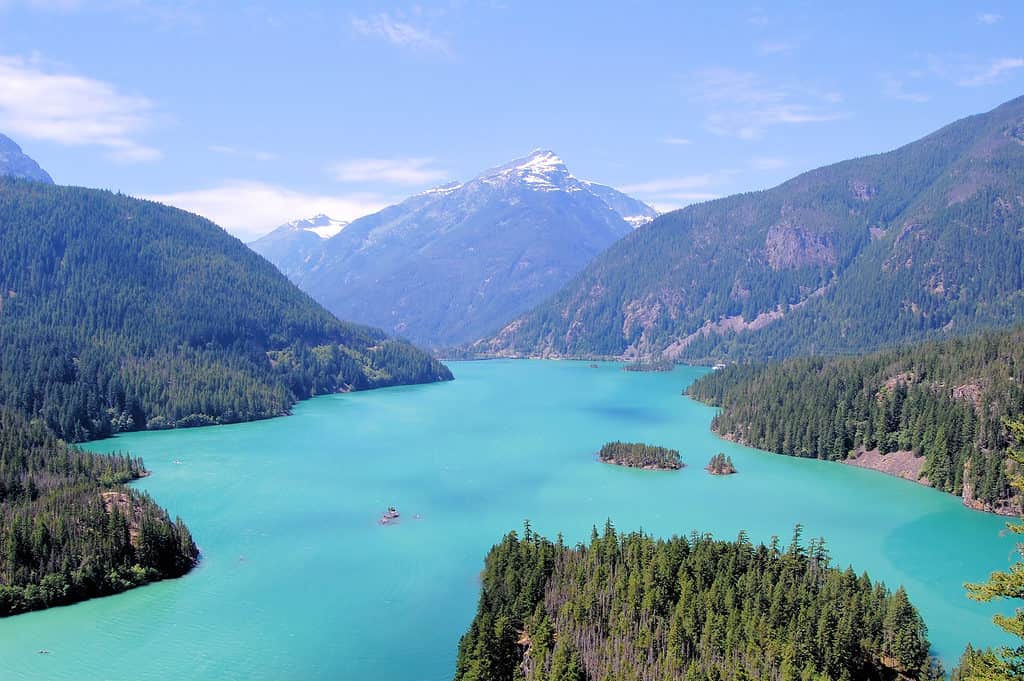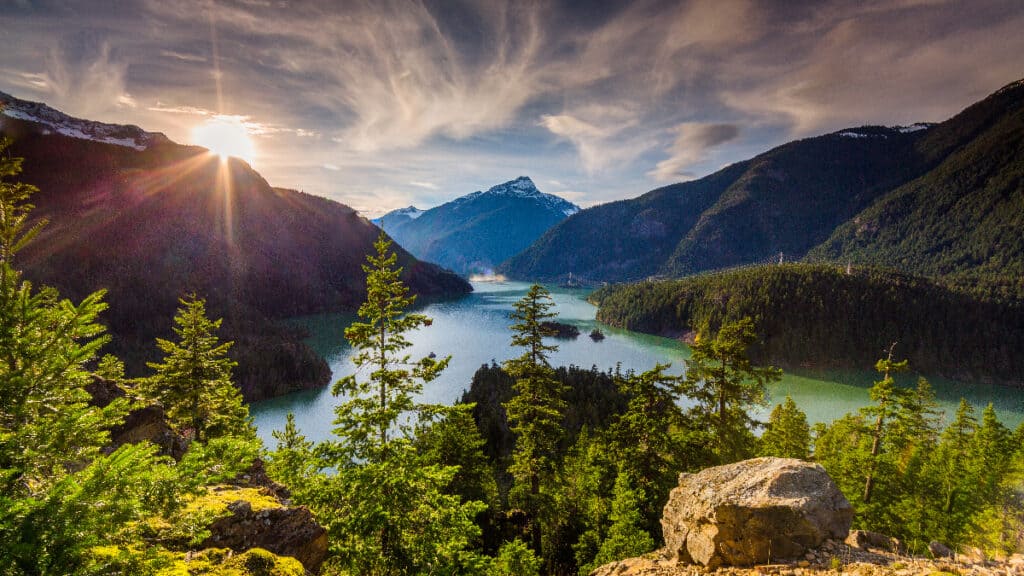If you plan to visit one of Washington State’s most popular lake locations, you may wonder how deep Diablo Lake is. After all, this is a popular lake for water activities and hiking! As a result, you may want to know if it’s the right lake to add to your itinerary.
Many factors influence the depth of a lake, and Diablo Lake is no exception. That’s why we created this guide. We’ll walk you through everything you need to know about this lake, from its size to its climate.
Ready to learn more? Let’s dive in!
How Deep Is Washington’s Diablo Lake?
Diablo Lake is a unique lake in Washington state. It is a reservoir in the North Cascade mountains, created by the Diablo Dam and located between two other lakes, Ross Lake and Gorge Lake, on the Skagit River.
Diablo Lake can reach a maximum depth of 320 feet. The lake covers around 1.42 square miles and sits at an elevation of around 1,201 feet.

Diablo Lake can reach a maximum depth of 320 feet.
©iStock.com/AlbertPego
Where Is Diablo Lake Located on a Map?
Diablo Lake is within Ross Lake National Recreation Area in Whatcom County. It is around two hours drive from Seattle and is six miles northeast of Newhalem.
More About Diablo Lake
Wondering exactly what makes this lake so unique? Look no further than its pigment. One of the most notable parts of this lake is its brilliant, beautiful colors. The waters are a deep, rich blue that looks right out of a picture book. This color comes from a fine powder known as glacial flour. Glacial flour is produced when glaciers grind the nearby rocks, producing a powder that then enters the lake and stays suspended, giving it this unique color.
History
As you learned, Diablo Lake was created by a dam called Diablo Dam, which sits on the Skagit River in Washington. This is one of three dams on the river, and it helps supply Seattle with its power. Both the dam and the lake can find their namesakes in the surrounding granite gorge, which is known as Diablo Canyon.
When Diablo Dam was first constructed, it was considered the tallest dam in the entire world! This was in 1930, and the dam stood 389 feet tall. Since then, however, many other dams have been built not only in the United States but in the world, and many have replaced the Diablo Dam as the tallest.
In 1981, many decades after the creation of Diablo Lake, a national recreation trail was created. This trail, known as Diablo Lake Trail, is 3.80 miles long and runs along the lake’s shore.
Climate
Diablo Lake is located in the northwestern region of Washington, near the Canadian border. As a result, its climate resembles that of the surrounding areas. Because the lake is located in the Cascade Mountains, which act as a bisect for the state’s variable climates, Diablo Lake can experience various types of weather.
Typically, thanks to its northern position, the climate is mild. Western regions may be drier, while rain can come in off the coastal areas and settle in the eastern parts of the state.
Overall, Washington state as a whole has a fairly temperate climate. The east is considered to have a semi-arid climate, while the coastal west is known for its cool oceanic climate. Because the state sits on the coast of the Pacific Ocean, the sea can play a large role in weather patterns, specifically the high and low-pressure systems that impact the state. Washington also sits on the border with Canada, which means it is more vulnerable to the prevailing winds of the north than some other states.
Because Diablo Lake is in the northern middle of the state, it is especially vulnerable to cold air moving south. This is even more true given the mountains, which can allow for different types of weather to become trapped.

Diablo Lake is especially vulnerable to cold air moving south.
©Roman Khomlyak/Shutterstock.com
Wildlife
Aside from its color, another one of the most interesting things about Diablo Lake is the wildlife you may find. You’ll find a variety of native species, including the rainbow trout, coastal cutthroat trout, and brook trout. However, you can also find bull trout.
The bull trout is listed as vulnerable on the IUCN Red List of Threatened Species. It is named for its unusually wide head and mouth, where it derives its name. Although it may seem like they can feasibly be confused for one of their trout cousins also found in Diablo Lake, this species is actually quite unique! They lack the brook trout’s dorsal spots and lake trout’s forked tails.
The photo featured at the top of this post is © iStock.com/Joecho-16
Sources
- Northwestern Division, U.S. Army Corps of Engineers, Available here: https://www.nwd-wc.usace.army.mil/dd/common/projects/www/dia.html
Thank you for reading! Have some feedback for us? Contact the AZ Animals editorial team.






